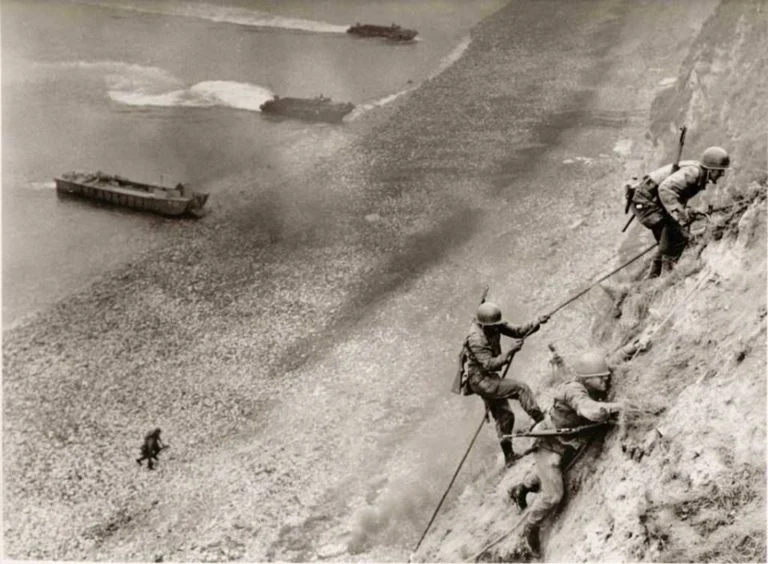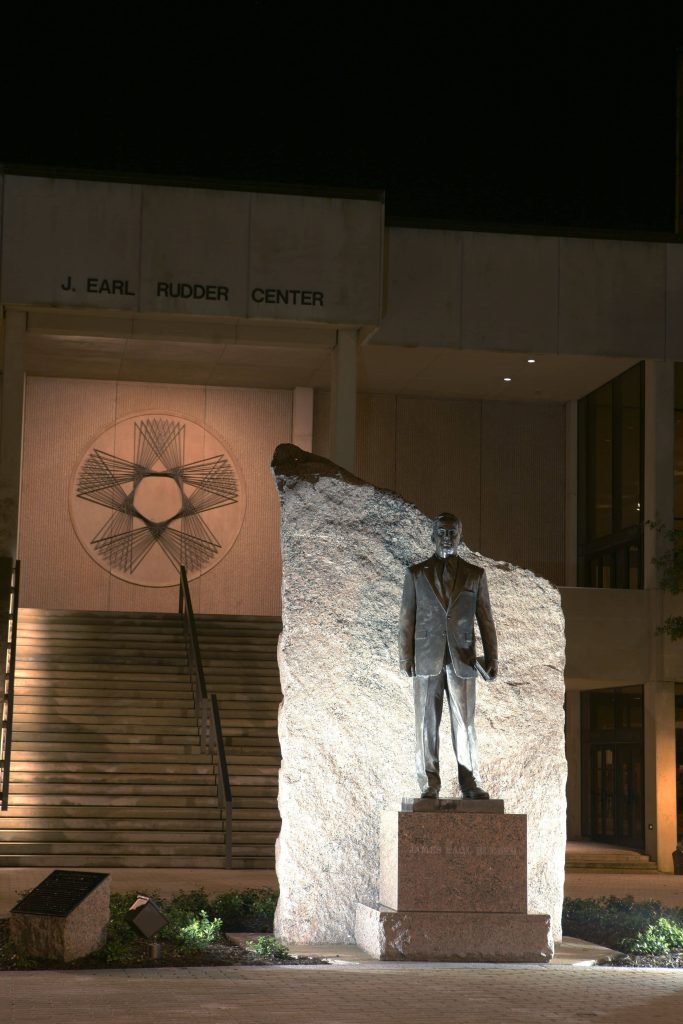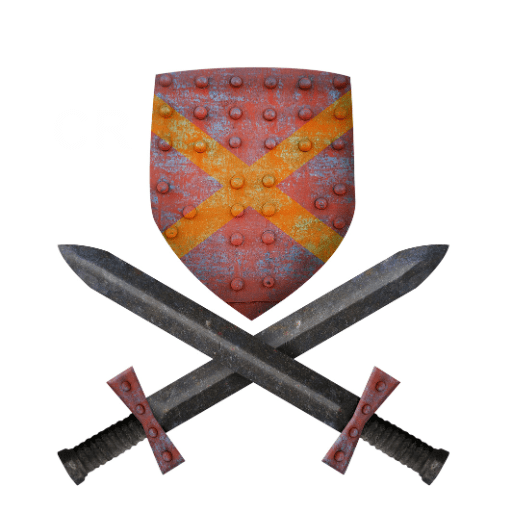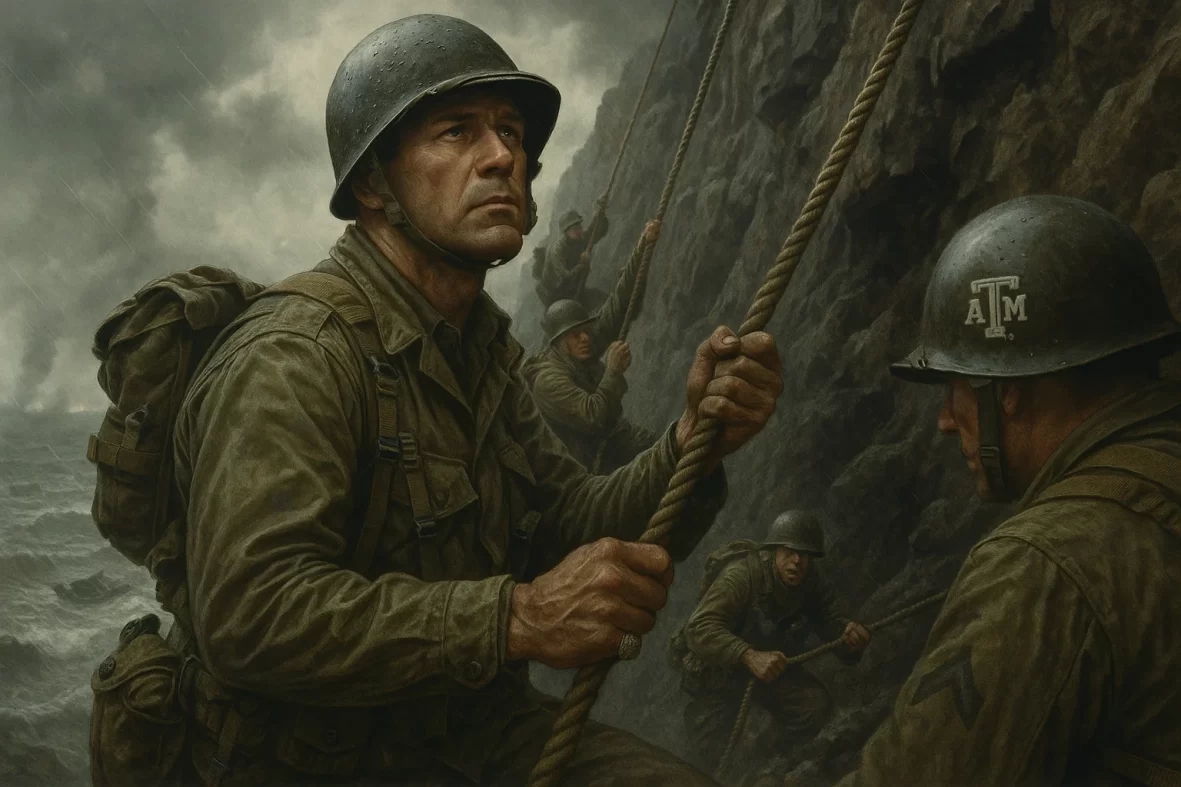“Greater love has no one than this, that one lay down his life for his friends.” — John 15:13
On June 6, 1944, as the largest amphibious invasion in human history unfolded across the beaches of Normandy, a small, determined band of men faced an impossible task.
Their objective was not a beach, but a cliff.
Towering nearly 100 feet above the English Channel, Pointe du Hoc stood like a natural fortress, bristling with German fortifications. Intelligence reported that six 155mm guns perched there, capable of raining destruction on both Omaha and Utah beaches, the very heart of Operation Overlord. If those guns remained operational, thousands of Allied soldiers would perish before ever reaching shore.
Neutralizing Pointe du Hoc was not optional. It was critical.
And so, in the early morning hours of D-Day, 225 men of the U.S. Army’s 2nd Ranger Battalion approached the rocky shoreline under the command of Lt. Colonel James Earl Rudder, an unlikely battlefield commander from the small town of Eden, Texas. But to Aggies, Rudder’s name is legendary.
He was one of their own.
The Call of the Cliffs
The men tasked with the assault knew the odds. The towering cliffs offered no natural pathway upward. The Germans had fortified the edges with barbed wire, landmines, and machine-gun nests. The Rangers would have to land in rough seas, under direct fire, then scale the cliffs using ropes, ladders, and their bare hands—all while exposed to the full fury of the German defenders above.

The moment their landing craft lowered the ramps, they came under withering fire. Several boats were destroyed before they even reached shore. Yet the Rangers pressed forward, crashing into the rocks, launching their ropes upward into the teeth of enemy fire.
As the ropes ascended, so did the men.
One by one, drenched, exhausted, but determined, they clawed their way upward. Grenades rained down. German soldiers cut ropes. Machine guns spat death from above. Still they climbed.
One Ranger later described it simply:
“There was no choice but up.”
The Rangers’ Triumph
When the Rangers reached the top, they made a stunning discovery: the feared German guns were not there. In the preceding days, the Germans had moved the artillery pieces inland to protect them from Allied bombing.
But Rudder’s men were not deterred.
Quickly, they dispatched patrols into the countryside. Within hours, they located the artillery pieces hidden along a hedgerow. Using thermite grenades and explosives, they disabled every one of them—neutralizing the threat before those guns could fire a single shot into the Allied invasion below.
Then came the hard part: holding Pointe du Hoc.
For two days, Rudder’s men held the ground under constant German counterattacks, snipers, and artillery. By the time reinforcements arrived, fewer than 90 Rangers remained combat effective. Their sacrifice had secured a vital victory and likely saved thousands of lives across the beaches of Normandy.
As General Omar Bradley later said:
“No other unit in the American Army could have done what the Rangers did that day.”
The Bigger Picture of D-Day
While Pointe du Hoc has rightfully earned its place as one of the most heroic chapters of D-Day, it was one piece of a vast, coordinated assault that stretched across 50 miles of Normandy coastline:
- Utah Beach (American forces)
- Omaha Beach (American forces — the bloodiest landing of the day)
- Gold Beach (British forces)
- Juno Beach (Canadian forces)
- Sword Beach (British forces)
Altogether, over 156,000 Allied troops landed on June 6, supported by 5,000 ships and 11,000 aircraft. The beaches were secured at tremendous cost: thousands were killed or wounded in the first 24 hours.
Yet the foothold was established. The tide of the war shifted. Nazi Germany’s days were numbered.
And high atop Pointe du Hoc, the battered Rangers stood as silent sentinels of what courage under fire looks like.
An Aggie Legacy Etched in Stone
For Texas A&M University, the name Rudder carries deep meaning.

After the war, James Earl Rudder returned home not as a celebrity but as a servant. In 1959, he became president of Texas A&M and guided the university through one of its most significant transformations. Under his leadership:
- Texas A&M opened its doors to women.
- Military membership became optional.
- Academic programs expanded nationally.
- The university’s identity was preserved while adapting for a new generation.
Rudder’s leadership embodied the Aggie Core Values long before they were officially articulated: Respect. Excellence. Leadership. Loyalty. Integrity. Selfless Service.
Today, his legacy remains deeply embedded in Aggieland:
- Rudder Tower rises at the heart of campus.
- The Aggie Ring, worn by generations of former students, whispers the quiet courage of those who came before.
- The Corps of Cadets continues to train leaders for military and civilian life.
- And every Aggie learns the story of the Rangers at Pointe du Hoc.
In truth, it is not merely an Aggie story. It is an American story. A story of ordinary men called to extraordinary courage in a world engulfed by darkness.
The Christian Reflection: Courage That Cost
As believers, we cannot read the story of Rudder’s Rangers without hearing the echo of greater truths. For on the greatest battlefield of all—the cross of Calvary—our Lord Jesus Christ faced impossible odds and paid the ultimate price for our salvation.
“For while we were still helpless, at the right time Christ died for the ungodly.” Romans 5:6
Like the Rangers who scaled the cliffs not knowing if they would live or die, Christ set His face toward the cross, enduring its agony for the joy set before Him (Hebrews 12:2). His victory has secured eternal freedom for those who believe.
Rudder’s Rangers remind us that freedom is never cheap—whether temporal or eternal. It is bought with blood.
Pointe du Hoc Today: A Sacred Monument
If you visit Normandy today, the cliffs of Pointe du Hoc still bear the scars of battle. Craters pockmark the ground. German bunkers remain. And standing near the cliff’s edge is the Pointe du Hoc Ranger Monument, a simple granite obelisk dedicated:
“To the heroic Ranger Commandos who under the command of Colonel James E. Rudder of the First American Division attacked and took possession of the Pointe du Hoc.”
The cliffs stand silent—but they speak volumes.
“No Other Unit Could Have Done What They Did”
Today, we remember.
- We remember the men of Rudder’s Rangers who scaled the cliffs.
- We remember the thousands who stormed the beaches.
- We remember the providence of God in turning the tide of history.
- And we remember that all true freedom ultimately flows from the One who laid down His life for His friends.
May we live worthy of the freedom secured at such great cost.
For further reading, visit:
- Pointe-du-Hoc, D-Day Overlord
- Army History: Rudder’s Rangers
- Normandy Tourism: Pointe du Hoc
- ABMC Pointe du Hoc Ranger Monument
- History Hit: Pointe du Hoc
Semper Fi. Gig ‘Em. Soli Deo Gloria.








